 Boxing/MMA
Boxing/MMA  Boxing Archive
Boxing Archive  Cleveland Sports Vault: 3/24/75. Don King Brings Ali-Wepner Home to Cleveland
Cleveland Sports Vault: 3/24/75. Don King Brings Ali-Wepner Home to Cleveland
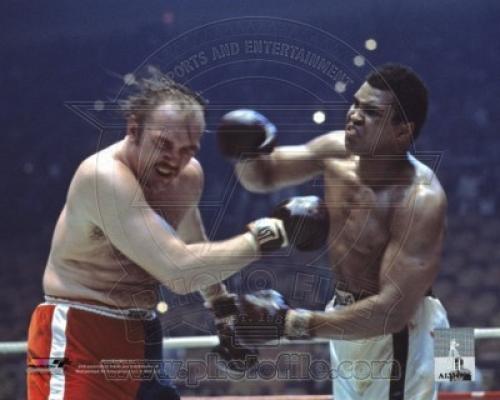 I am not going to sit here and pretend that the 1970s were better than any other decade in our history. The United States’ Cold War with the Soviets carried the implied threat of a nuclear strike. The war in Viet Nam was a confusing, polarizing mess. Civil unrest and failed leadership both resulted from, and contributed to, public discord.
I am not going to sit here and pretend that the 1970s were better than any other decade in our history. The United States’ Cold War with the Soviets carried the implied threat of a nuclear strike. The war in Viet Nam was a confusing, polarizing mess. Civil unrest and failed leadership both resulted from, and contributed to, public discord.
Unquestionably, however, between music, movies, and the like, the entertainment industry was highly compelling. And while it was true that television markets were limited to a handful of available channels, the American public was treated to plenty of intrigue in the sporting world.
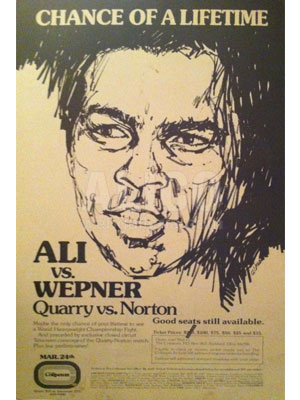 Much of that revolved around the heated rivalries in the individual sports, which were magnified by iconic personalities. Men’s tennis featured an ongoing drama involving Jimmy Connors, John McEnroe, Bjorn Borg, Ilie Nastase, John Newcombe, Arthur Ashe, and Vitas Gerulaitis. Men’s golf saw the battle of larger-than-life figures such as Jack Nicklaus, Lee Trevino, Tom Weiskopf, Hale Irwin, Johnny Miller, Tom Watson, and Gary Player.
Much of that revolved around the heated rivalries in the individual sports, which were magnified by iconic personalities. Men’s tennis featured an ongoing drama involving Jimmy Connors, John McEnroe, Bjorn Borg, Ilie Nastase, John Newcombe, Arthur Ashe, and Vitas Gerulaitis. Men’s golf saw the battle of larger-than-life figures such as Jack Nicklaus, Lee Trevino, Tom Weiskopf, Hale Irwin, Johnny Miller, Tom Watson, and Gary Player.
Boxing went toe-to-toe with the other sports. The heavyweight division was a constellation that orbited around the Muhammad Ali media monster. But there were several fighters who were contenders for title belts. Heavyweights who could actually call themselves “champion” in the 1970s included Ali, Joe Frazier, George Foreman, Ken Norton, Leon Spinks, and Jimmy Ellis. Several other contenders further spiced up the field 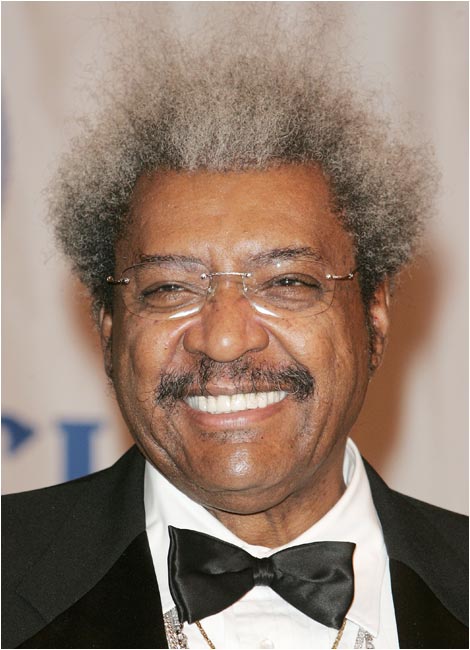 : Joe Bugner, Jerry Quarry, Ron Lyle, Earnie Shavers, Ernie Terrell and eventually Larry Holmes had varying degrees of success, sometimes throwing a scare into the champ.
: Joe Bugner, Jerry Quarry, Ron Lyle, Earnie Shavers, Ernie Terrell and eventually Larry Holmes had varying degrees of success, sometimes throwing a scare into the champ.
Promoter Don King exploded onto the world of heavyweight boxing in the 70s. One might say he basically worked for Muhammad Ali. He’d been a shadowy figure of the illegal gambling world in Cleveland in the 1950s and 1960s, and remains infamous for two killings he is linked with. The first involved a 1953 shooting that was ruled a justifiable homicide; the victim was shot while attempting to rob one of King’s gambling houses. King was convicted in the 1966 killing. He was found guilty of stomping an employee to death over the $600 he was owed. King served about four years at the Marion, Ohio prison. (He was later pardoned by Ohio governor James Rhodes, in 1983. Rhodes had received letters in support of King from such celebrities as former Indians executive Gabe Paul, Coretta Scott King, Jesse Jackson, George Voinovich, and Art Modell.)
The bombastic King became a boxing promoter after successfully pitching a Cleveland hospital charity event to Ali. He parlayed this association, along with his local boxing ties, into winning the promotion of the 1974 bout between Ali and George Foreman. The Rumble in the Jungle. All of the top boxing promoters (who, unlike Don King, were content to remain quietly away from the public spotlight) vied for this match. King secured the deal through his arrangement with the country of Zaire, and he guaranteed a record $10million purse. He made the deal with Foreman and Ali first, and then went about finding the financial backing. The event became a week-long festival, with musical acts performing during the week leading up to the match: James Brown, B.B. King, The Spinners, and Bill Withers were among the acts from the U.S.
Meeting and dealing with third world governments was a key strategy of King’s. He could drum up vast sums of money, increasingly from closed-circuit TV, and they could show the world how modern, fair, and happy their countries were (insert some measure of sarcasm here).
Chuck Wepner was a heavyweight out of New Jersey. He was known as the “Bayonne Bleeder” due to the cuts he sustained in the ring. Wepner was a part-time boxer- he still needed his full time job as a liquor salesman (a Marine veteran, he also had been a security guard and a club bouncer). He’d lost to Foreman, and had taken Sonny Liston ten rounds before losing that match. That was when he earned his nickname: his nose was broken for one of the 11 times in his career, he suffered a cracked cheekbone, and required 72 stitches. Whenever Liston landed a blow, Wepner’s blood splattered among the first few rows of patrons viewing the fight. (His eyes were also swollen shut. At one point, the referee asked how many fingers he was holding up. His manager patted him three times and Wepner said, “three.” 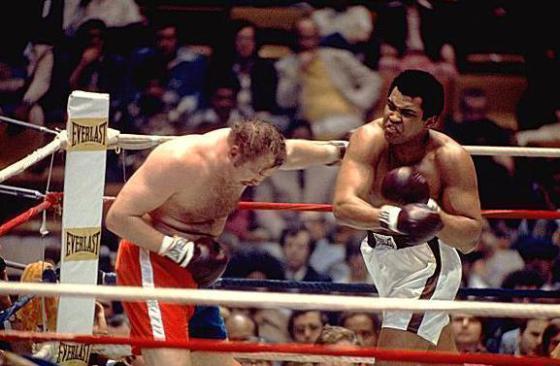 He was allowed to fight on.)
He was allowed to fight on.)
After a loss to Bugner, Wepner won 9 of his next 11 fights, including victories over such notables as Charlie Polite and Terrell. He still was not, however, among the heavyweight top ten. He acknowledges he was an improved boxer, explaining that he no longer stubbornly stayed inside with his opponent. And he now laughs that he began to duck more. Don King contacted Wepner, and set him up with a fight for a shot at George Foreman. Wepner won that first fight by knockout in the 11th round.
Ali was the underdog to Foreman in Zaire, in the upcoming, late 1974 Rumble in the Jungle. He had earlier been suspended from boxing for 3 ½ years, through 1970, for his unwillingness to serve in the U.S. military during the Viet Nam War. When he resumed boxing, he won a couple matches before losing to Joe Frazier in what was known as The Fight of the Century.
Foreman had won Olympic Gold in 1968 in Mexico City, and was widely feared for his size and power. He had defeated both Norton and Frazier- two boxers who had 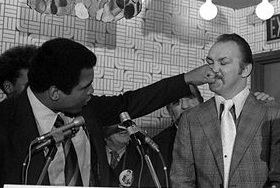 beaten Ali. Ali was hailed for changing his style for this fight. Gone was the evasive dancer, replaced by the “rope-a-dope” (deflecting punches at the rope, allowing the opponent to tire before attacking) and jabs. Ali’s strategy also included tattooing Foreman’s face, which grew swollen. Taking a huge toll on the favorite was Ali’s
beaten Ali. Ali was hailed for changing his style for this fight. Gone was the evasive dancer, replaced by the “rope-a-dope” (deflecting punches at the rope, allowing the opponent to tire before attacking) and jabs. Ali’s strategy also included tattooing Foreman’s face, which grew swollen. Taking a huge toll on the favorite was Ali’s 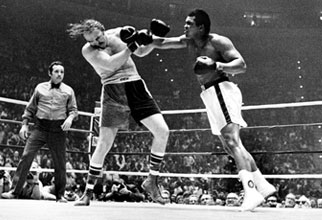 wresting tactics when they were in a clinch. Ali leaned on Foreman, tiring him over the course of the match.
wresting tactics when they were in a clinch. Ali leaned on Foreman, tiring him over the course of the match.
Ali beat the favored Foreman, regaining the heavyweight title. Chuck Wepner shrugged it off, assuming his title shot was not to be. King did not call. One evening, while Wepner was at home watching ‘Kojak’ (his favorite television show), his mother called him. He was in the middle of reminding her not to call him during his show when she told him the news: he was going to fight Muhammad Ali- it was in the paper. King was in Cleveland with Ali and had arranged the fight.
King was being loyal to his home town, and there was a beautiful, brand new facility where the fight could be staged: the Richfield Coliseum. Nick Mileti’s ‘Big House on the Prairie’ south of Cleveland would be a fine place to for the comeback champion Ali to have a ‘tuneup’ on the way to his third match versus Joe Frazier.
The bout between Muhammad Ali and Chuck Wepner was held in the spring of 1975, just as the Indians’ Frank Robinson was making history as major league baseball’s 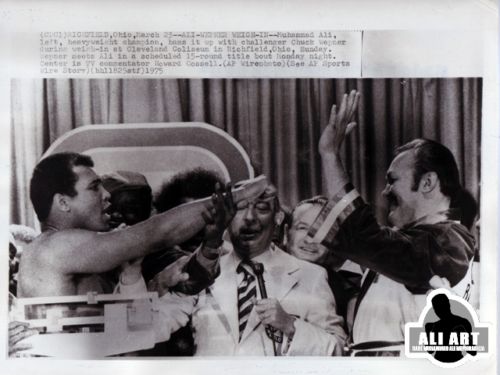 first black manager. Ali was to receive $1.5million, and Wepner, $100,000. It was not actually a title bout, although
first black manager. Ali was to receive $1.5million, and Wepner, $100,000. It was not actually a title bout, although 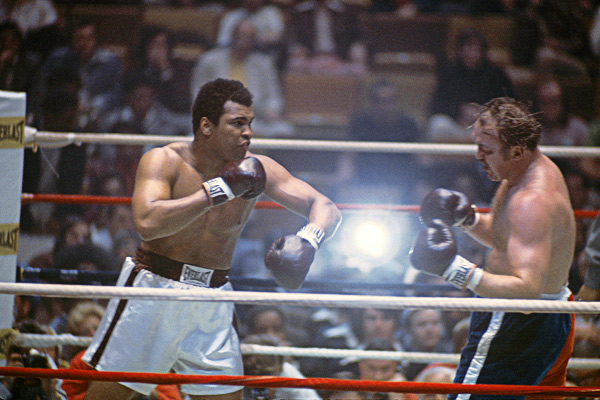 Don King promoted it as such (this is a fact that is misunderstood today. The fight was not sanctioned since Wepner was not highly ranked). Ali arrived in Cleveland ten days prior to the fight. He was not in top boxing shape, and began jogging through the Metroparks. He spent time giving support to a mosque in the Lee-Harvard area.
Don King promoted it as such (this is a fact that is misunderstood today. The fight was not sanctioned since Wepner was not highly ranked). Ali arrived in Cleveland ten days prior to the fight. He was not in top boxing shape, and began jogging through the Metroparks. He spent time giving support to a mosque in the Lee-Harvard area.
Chuck Wepner trained for seven weeks. For the first time in his life, he was able to train full-time; his employer arranged for him to have the time off. Curiously, Ali did not trash-talk Wepner, nor did he give him a nickname. Ali was famous for creatively talking down his opponents, and was particularly brutal with Joe Frazier. (Google or YouTube that if you care to. Ali was relentless with Frazier.)
Here is Part 1 of a prefight Mike Douglas show, with both Ali and Wepner.
Here is Part 2, when the old Ali schtick comes out. Watch this one for sure.
At the Coliseum, in front of 14,000, Ali toyed with the 40:1 underdog Wepner through much of the fight. In the ninth round, Wepner stepped on Ali’s right foot while delivering a body punch, and Ali went down. Much has been made of this ‘knockdown’, and Wepner continues to call it a knockdown to this day. It’s pretty clear, from photos, that Ali was stepped on (right). Ali took the eight count without complaining, but was up and waiting to fight even before it started. Meanwhile, Wepner was thinking he might win…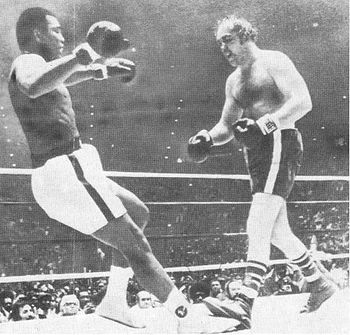
This flipped a switch in Ali. He was angry now. From that point on, he used his speed and athleticism against Wepner. In the decisive fifteenth round, Ali peppered 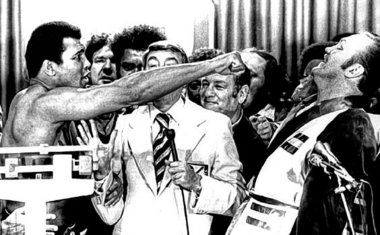 Wepner’s face. Wepner staggered to the ropes, and went down. The ref called the match about twenty seconds before the end of the round; Wepner says the ref later told him if he knew there was only that much time left in the round, he would have let him fight on.
Wepner’s face. Wepner staggered to the ropes, and went down. The ref called the match about twenty seconds before the end of the round; Wepner says the ref later told him if he knew there was only that much time left in the round, he would have let him fight on.
Funny story: Wepner talks about how he bought his wife a sexy negligee a few days before the Ali fight. He told her he wanted her to wear it to bed the night of the fight because she would be sleeping with the heavyweight champion of the world. After the fight, when Wepner returned to her in their hotel room, she was wearing the negligee. She asked him “Am I going to Ali’s room or is he coming to mine?”
Famously, a relatively unknown Hollywood talent named Sylvester Stallone had watched the Ali-Wepner fight, and used it as inspiration for the Rocky movies. Also, Wepner's later fight with professional wrestler Andre the Giant is seen as the inspiration for Rocky’s battle with Thunderlips (Hulk Hogan) in Rocky III.
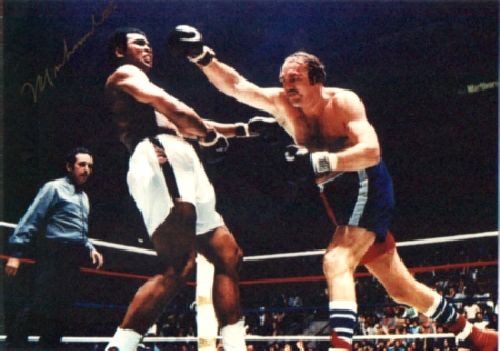 Chuck Wepner continued to box after the fight in Cleveland, although Ali had no interest in a rematch. Wepner was too tough to beat, and too lowly ranked, for a contender to deal with.
Chuck Wepner continued to box after the fight in Cleveland, although Ali had no interest in a rematch. Wepner was too tough to beat, and too lowly ranked, for a contender to deal with.
Muhammad Ali won a couple more fights before the next big Don King promotion, later in 1975: The Thrilla in Manila, against Joe Frazier.
Here are some YouTube clips. Notice the red wind-breakers worn by the patrons sitting in the front rows. These were given to them as protection from the blood of the Bayonne Bleeder.
Rounds 8, 9 and 10. 4:35 is where Ali goes down.
These days, Chuck Wepner is enjoying a gracious retirement. People remember him, and his big shot on the biggest stage in the world, versus Muhammad Ali.
Thanks to Don King, in Cleveland.
Thank you for reading. By the way, did you notice the signature lines of lights in the stairways of the Coliseum in the above photos on the right? There is also a glimpse of the loges ringing the top of the stands.
Sources included:
TIME, Monday, April 7, 1975. Sport: In Stitches
SI Vault, June 30, 2003. The Real-Life Rocky, Michael Farber
SI Vault, September 15, 1975. ‘there Ain’t No Others Like Me’, Mark Kram
ESPN.com. ‘Real Rocky’ Wepner finally getting due, Eric Raskin
AARP.org, March 24, 2011. Boxer Chuck Wepner Decked Muhammad Ali, Bruce Lowitt
Newjerseynewsroom.com, March 10, 2010. 35 Years after facing Muhammad Ali, ‘Bayonne Bleeder’ Chuck Wepner still pulls no punches, Jerry Milani
Wikipedia entries for Muhammad Ali, Chuck Wepner, Don King, Joe Frazier, Rope-a-Dope, Thrilla in Manila, Rumble in the Jungle, Boxing in the 1970s.
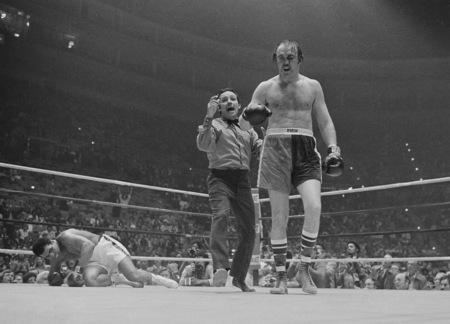
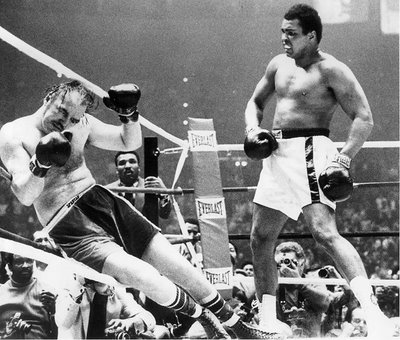
- NBA Announces 2013-2014 Schedule
- Browns Ink Sharknado
- Sharknado A No-Show For Rookie Camp
- Trent Richardson Out Until Training Camp
- Browns Sign Brandon Jackson
- Carrasco Suspended Eight Games
- Browns Add to Wide Receiver Depth with David Nelson
- Browns Need to Learn from Past Draft Mistakes
- Browns Release Chris Gocong and Usama Young
- Browns Missing on Grimes Disappointing, But Not The End
The TCF Forums
- Official- Browns Coach Search/Rumors
Larvell Blanks (Tuesday, January 21 2014 11:53 AM) - The 2014 Offseason Thread
skatingtripods (Tuesday, January 21 2014 11:52 AM) - Chris Grant's first 3 drafts
Kingpin74 (Tuesday, January 21 2014 10:13 AM) - 2015 Recruiting
furls (Tuesday, January 21 2014 6:57 AM) - Mike Brown
YahooFanChicago (Monday, January 20 2014 11:15 PM) - Movies coming out
HoodooMan (Monday, January 20 2014 9:34 PM) - 2014 Hoops Hockey Hijinx
jpd1224 (Monday, January 20 2014 4:44 PM) - 2014 Recruiting
jclvd_23 (Monday, January 20 2014 2:26 PM) - Wish List - #4 Pick
Hikohadon (Monday, January 20 2014 1:26 PM) - #1 overall pick Anthony Bennett
TouchEmAllTime (Sunday, January 19 2014 1:28 PM)


